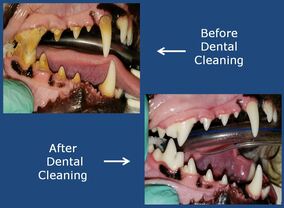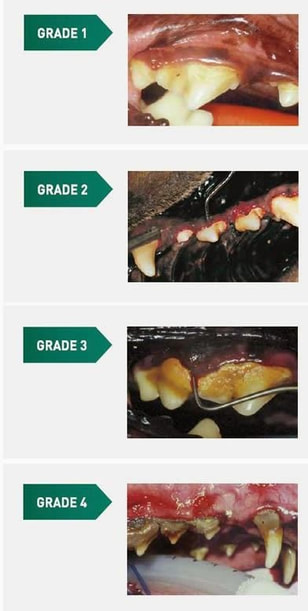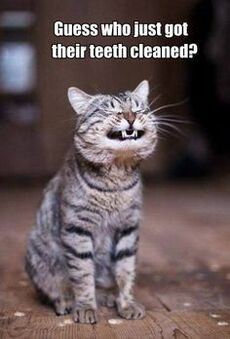Dental Care

When dental calculus (tartar) forms on your pet's teeth it is composed of various mineral salts, bacteria, organic material and food particles. In the early stages of accumulation, the material is soft (plaque), but it later hardens and adheres to the teeth. Continual accumulation causes inflammation of the gums and eventual recession of the gums and loose teeth.
Animals get periodontal disease, gingivitis and tooth decay just like humans! The breath becomes very odorous and the mouth becomes a dangerous source of infections. As most of us know, unhealthy gums and teeth can become very painful. What you don't see happening is the untreated tooth and gum disease allow bacteria to enter the bloodstream and causing not only infections but also eventually severe damage to the valves of the heart, kidneys and the liver.
The combination of regular dental check ups/cleanings, proper nutrition and brushing at home can add years to your pet's life and prevent many disease processes. Keeping up on your pets dental health can also save you money in the long run. Prevention costs less than treatment. Dogs and cats most often begin showing signs of periodontal disease (gum disease) by the time they reach about 3-4 years of age.
If your pet has bad breath or you have concerns about their oral health. Call us today and we will come up with a plan together.
Animals get periodontal disease, gingivitis and tooth decay just like humans! The breath becomes very odorous and the mouth becomes a dangerous source of infections. As most of us know, unhealthy gums and teeth can become very painful. What you don't see happening is the untreated tooth and gum disease allow bacteria to enter the bloodstream and causing not only infections but also eventually severe damage to the valves of the heart, kidneys and the liver.
The combination of regular dental check ups/cleanings, proper nutrition and brushing at home can add years to your pet's life and prevent many disease processes. Keeping up on your pets dental health can also save you money in the long run. Prevention costs less than treatment. Dogs and cats most often begin showing signs of periodontal disease (gum disease) by the time they reach about 3-4 years of age.
If your pet has bad breath or you have concerns about their oral health. Call us today and we will come up with a plan together.
Do you want to know how to brush your pets teeth?
Click Here for information on how to brush your dog's teeth
Click Here for information on how to brush your cat's teeth
Click Here for information on how to brush your cat's teeth

3-way performance that cleans teeth, freshens breath and supports proper digestion.
- CLEANSE
Just one chew daily reduces tartar and plaque, the oral causes of bad breath. - FRESHEN
Freshens breath with every chew. - BALANCE
Contains a prebiotic known to support proper digestion.
Veggiedent daily chews can help keep your pets teeth healthy! AVAILABLE NOW
What goes into a dental cleaning for my pet?
Unlike humans, veterinary dentists can't just ask your dog to say “Ahhh"
Veterinary dentistry is a complicated procedure that involves multiple licensed skilled professionals, bloodwork, advanced equipment, x-rays and anesthesia. Like us, all pets are unique, so no two dental cleanings will be exactly alike or cost exactly the same.
Full veterinary dental care cannot be safely and successfully carried out unless anesthesia is used.
Getting a proper look at your pets teeth, performing x-rays and cleaning the teeth below the gums cannot be done in an awake animal, which is why anesthesia is necessary. Performing dental x-rays helps reveal if any teeth need to be removed.
Prior to your pet's dental procedure appointment we will run pre-surgical blood work to ensure that anesthetic drugs are safe to use on your pet as well as potentially start your pet on some antibiotics, if needed, to help clear up any oral infections.
On the day of your pet's procedure, your pet will be put under anesthesia. We will perform a complete oral exam and take dental x-rays to help determine if any teeth are compromised and need to be removed. We will then begin to clean the surface of your pet's teeth. This part is relatively similar to how your own teeth get cleaned when you visit the dentist. We use modern and safe ultrasound technology to clean each tooth thoroughly -above and below the gum line. A variety of instruments are used to identify and remove all plaque and tartar from your pet's mouth. If any teeth need to be removed those will get extracted by the Veterinarian. Following this, we will perform a deep cleaning and polishing of the teeth to create a smooth, lustrous tooth surface that is more resistant to plaque buildup. When your pet's dental procedure is completed, a healing and soothing laser therapy treatment is applied.
Office HoursMonday: 8:00 am to 5:00 pm Tuesday: 8:00 am to 7:00 pm Wednesday: 8:00am to 5:00pm Thursday: 8:00 am to 7:00 pm Friday: 8:00 am to 5:00 pm Saturday: Closed Sunday: Closed |
|
Site powered by Weebly. Managed by IDEXX Laboratories







